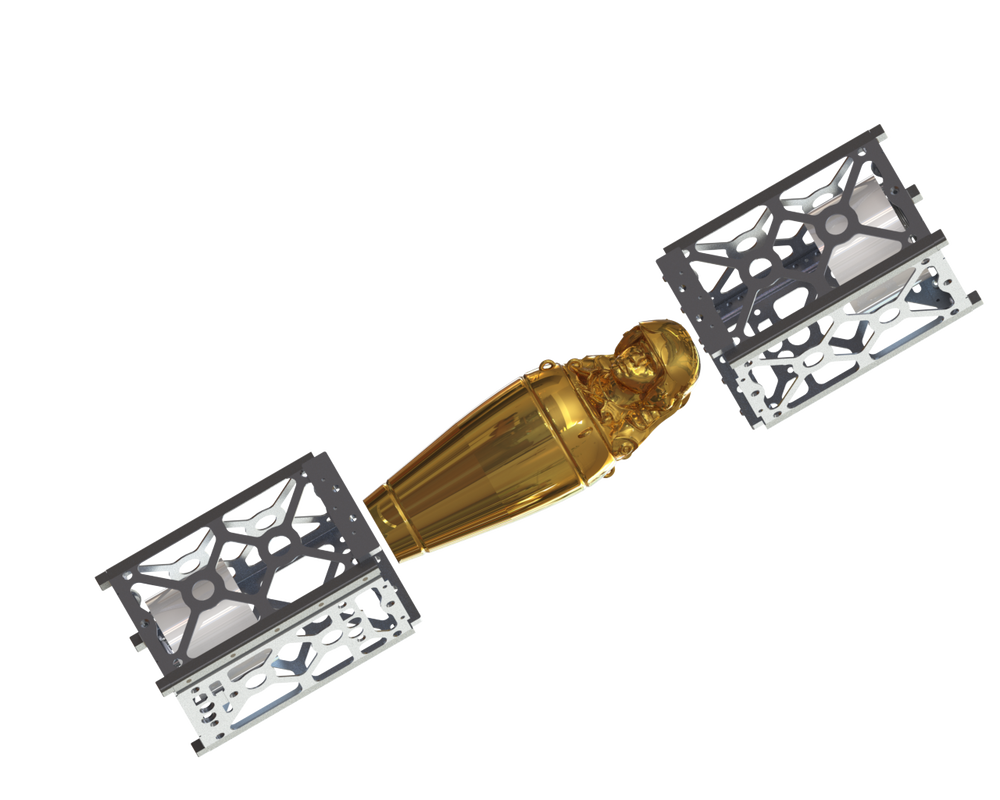|
FLEET Space's Centauri 1 was deposited into its intended orbit by India's PSLV-C43 yesterday, and has already broadcast some initial health and status information. The Centauri CubeSats Pumpkin built for FLEET Space have best-in-class solar arrays, batteries and structural integrity, along with a 1GHz Linux C&DH platform. Centauri 1 & 2 are comprised of:
 Centauri 1, with panels deployed and UHF antenna still in stowed position. Centauri 1, with panels deployed and UHF antenna still in stowed position. When FLEET Space had a last-minute opportunity to launch 3U worth of CubeSats on a Rocket Lab Electron launch vehicle, with the caveat that the CubeSats had to be ready in two weeks (!), they came to Pumpkin. We not only typically have nanosatellite-class equipment in stock, but we also have a proven track record of working quickly on projects that require outside-of-the-box thinking. Within two weeks, we needed to come up with a working architecture, source the required components / assemblies, make any modifications required, integrate the FLEET payload and antennas (the pixelated portion above), and provide a software framework upon which FLEET could write their mission software.
Given the very short notice and the desire to maximize the utility of the 3U of volume available on this ride, Pumpkin and FLEET settled on a dual-1.5U mission, with two hardware-identical 1.5U CubeSats. We decided to go with a battery-power-only architecture, as that reduced costs and complexity, and fits within the 1.5U available. Pumpkin immediately embarked on creating a new operating mode for our BM 2 battery; within a few days we had this up and running, and Proxima I/II were thus enabled. The two satellite were built with US and Australian teams working together and remotely, then environmentally tested with no issues, and finally delivered to Rocket Lab for LV integration. Proxima's Pumpkin components included:
The Pumpkin bus components occupy around half the volume and mass of each Proxima CubeSat; FLEET's payload(s) occupy the rest. The GPSRM along with its power-efficient orbit propagator enable Proxima's mission ops, and the low-power 16-bit PPM E3 PIC24 MCU running Salvo along with the BM 2 and its sleep mode guarantee an efficient use of the battery's available energy. Additionally, some of the code from Stanford University's QB50 project was donated to the Proxima mission, and lives on in Proxima I/II. More information on these CubeSats can be found here. In July 2015, Pumpkin was approached by the Los Angeles County Museum of Art (LACMA) to work with Bahamian artist Tavares Strachan to create a 3U CubeSat-size work of art to be launched into space. Influenced by a visit to the Neues Museum in Berlin, the result of this very successful working relationship between Pumpkin and the artist is a distinctive, unique and beautiful objet d'art, that happens to also carry some hi-tech tags that will simplify its tracking while on orbit. On Friday, November 2, 2018, the FAA "made a favorable payload determination for the ENOCH payload," and ENOCH is now cleared for launch on the Falcon 9 flight from Vandenberg AFB on November 19. You can read more about ENOCH and the artist behind it here, here and here. As part of the development of ENOCH, Pumpkin initially considered a scheme whereby ENOCH's canopic jar would be located inside two 1.5U CubeSat "shells" that would separate after launch. However, we ultimately felt that this was not a particularly elegant solution, and given the mass of the jar (it's made of cast brass), surviving shake and shock during the launch to properly separate thereafter would likely prove problematic and frankly, too much trouble. That's when AEK visited the Neues Museum in Berlin and saw Nefertiti's bust in its new home. Our new approach was to present the canopic jar in a manner that focused the viewer's eyes on the jar, and not on the surrounding materials required for launch. With this new direction for ENOCH, we created a "sled" that is compatible with Planetary System Corporations Canisterized Satellite Dispenser (CSD). This resulted in a design that exposed the canopic jar as much as possible, and let the sled "fade into the background." Hence the deep black color to the sled. This layout meant that the canopic jar was heavily cantilevered at one end, which led to a few iterations when a lower-than-acceptable fundamental frequency was discovered during environmental tests. The base below the canopic jar also incorporates (hidden from view) the requisite hardware to vent the interior volume of the jar, as well as permanent magnets and hysteresis material to help ENOCH establish a stabilized attitude while on orbit. The sled has "feet" on the top and bottom, with an isogridded structure for strength and lightness, for symmetry and in order to satisfy the CSD requirements. Lastly, since LACMA is not your typical satellite operator, we felt that adding a means to track ENOCH's orbit would be very useful, and so with LACMA's blessing we added three radar retroreflectors supplied by the US Navy to the structure (the white squares). With these radar tags, it will be relatively straightforward to track this "passive" nanosatellite.
We wish the ENOCH mission all the best. A fitting tribute to fallen astronaut Robert Henry Lawrence Jr. |
Archives
March 2024
Categories |
Home |
About Us |
Store |
Salvo RTOS |
Contact
|
Copyright © 2015-2022





 RSS Feed
RSS Feed